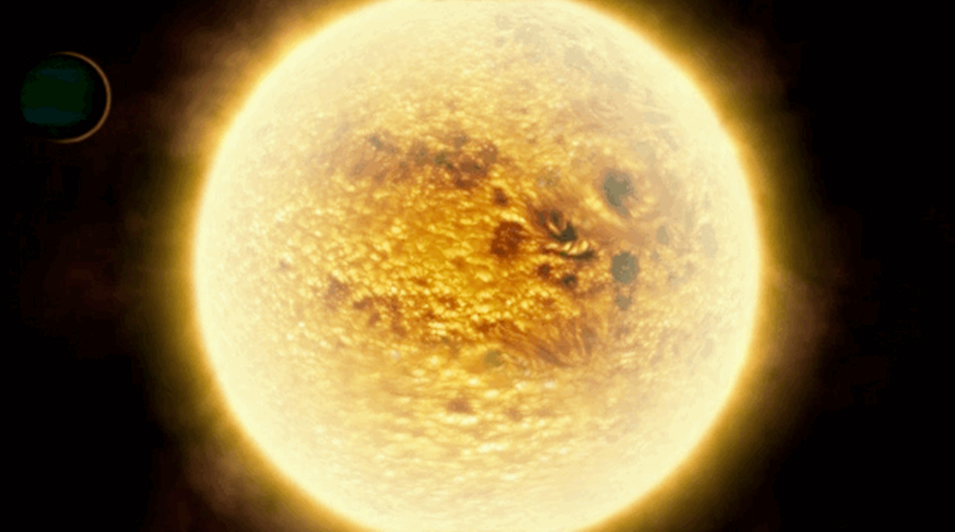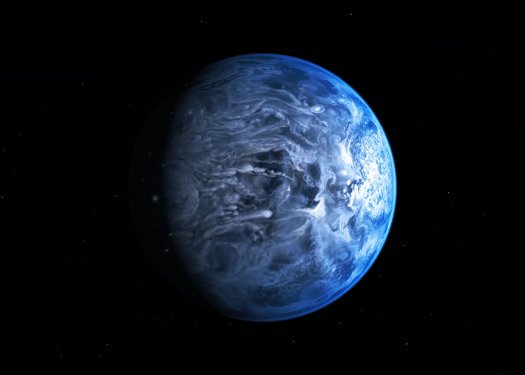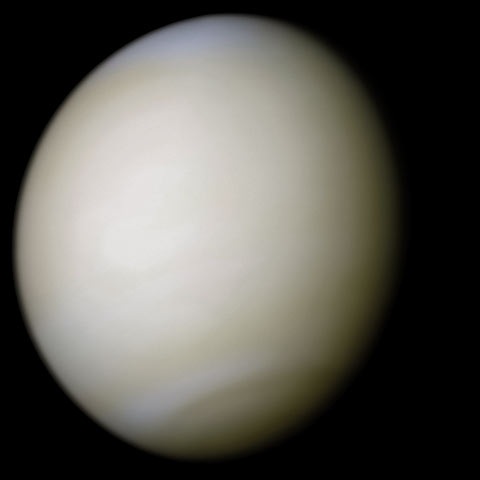Other planets
Honestly, the high activity in the discussion of the first post came as a surprise. A pleasant surprise, which is already there. Genuine interest, a large number of constructive comments and additions, a variety of points of view regarding the issues raised in that post showed that such topics are really close to the Habr community. Therefore, I decided to continue the "cosmic" direction in this blog article today.
In almost every science fiction film that takes place in outer space, we are somehow shown how other planets look. Alas, these diverse and picturesque pictures are a figment of the imagination of artists and designers. Until recently, humanity did not have the opportunity not only to consider the details, but even to understand the general color of the planets rotating in other star systems. The problem is that even the most advanced telescopes, located in orbits around the Earth and not subject to distortions introduced by its atmosphere, are not able to give a sufficiently detailed image of exoplanets (as any planet outside the solar system is designated). This is due to the fact that, compared with the stars of the planet, they have a catastrophically small brightness and are physically many times less.
Due to the fact that the stars simply overshadow the planets rotating around them, scientists usually determine the fact of the presence of these planets by indirect signs. For example, according to short-term weak changes in the spectral composition of a star, when a planet passes between its luminary and its observers.

63 light years from the old Earth, in the constellation Lysychka (Vulpecula) there is a small star about ¼ smaller than the Sun, with the cute name HD 189773. A gas planet is discovered around it, discovered in 2007 and named just as witty: HD 189773b. Its existence was just discovered due to the passage of a star against the background of a disk. Being one of the closest known exoplanets to us, HD 189773b has earned the honor of being the first to appear, so to speak, in its true form. Such gas planets, comparable in size to Jupiter and rotating at a fairly small distance from their stars, were called astronomers by hot Jupiters . According to scientists, planets of this type should be quite common in the universe.
To determine the color of the planet, astronomers first had toseparate flies from cutlets to clear the spectrum of light reflected by the planet from the spectrum of the star itself. To do this, using the spectrograph of the Hubble orbital telescope (Hubble) scanned this star system before, during and after the passage of the planet against the background of the star. This became possible due to the successful location of the orbit plane. The luminosity of HD 189773b is about 0.0001 of the brightness of its parent star. After analyzing the spectral composition of the radiation in these three cases and the albedo of the planet, scientists found that HD 189773b has an azure blue color. Something like a pale blue dot from space. However, the similarity ends here. In our case, the blue color is due to the presence of water in the atmosphere and on the surface of the planet. In contrast with the cozy Earth, HD 189773b can be called one of the branches of hell. Judge for yourself:
So, returning to the topic of the article, this cute planet has a blue color just because its atmosphere is filled with dust from silicon compounds, that is, glass. By the way, all this horror should, according to scientists, be brightened up by beautiful crimson sunsets ...

Alas, so far this is the first and only study of this kind. Despite the fact that astronomers now know a little less than 900 exoplanets, their colors are still unknown to us. There are various reasons for this, among which the limited capabilities of surveillance devices do not always play a major role. Take, for example, the closest star system to us - Alpha Centauri. It is located just 4.4 light years from the Sun, and not 63, like HD 189773. Due to its proximity to us and its sufficient brightness, Alpha Centauri has been an object of observation of astronomers for centuries. But only last year a planet was discovered in this star system. It turns out that all this time it was impossible to detect due to the fact that it is located too close to its star. As a result, the star’s radiation is so much higher than the intensity of the light reflected by the planet,HARPS , specially designed for the finest measurements to search for exoplanets. The proximity to the star is also the reason that the temperature on the surface of this planet reaches 1200 degrees Celsius.
Today, our information on exoplanets is extremely insignificant. The number of stars in our Milky Way galaxy alone is approximately estimated at 100-400 billion. Recent research suggests that theaverage hospital temperature for an average of 1.6 stars per planet, so potentially there are approximately 500 billion planets in the Milky Way. True, as can be seen from the two examples above, not all planets are “equally useful” from a practical point of view. Today it is believed that the number of potentially habitable planets in our galaxy can reach 17 billion (in this place, all ufologists exhale together).
It must be said that it is far from always possible to establish the reason why the celestial body has this or that color. For examples, you do not need to turn to other constellations: scientists still can not clearly say why Jupiter and Venus have just such a color.


Of course, scientists have put forward a number of hypotheses, but the composition of the clouds covering the entire area of Venus is still not known, even despite the unique Soviet research program on this planet. The origin of the colors of the remaining planets in the solar system is generally well known to scientists. Perhaps the most aesthetically interesting can be called Mars and Neptune. And if the appearance of the “red planet” has already become a hackneyed stamp, then the most distant planet has not in vain received the name of the god of the seas: ultramarine color is given to the planet mainly by methane vapor in the outer layers of the atmosphere.

Since we are still formally alone in the Universe, the only celestial body today, the color of which is determined not only by the chemical composition of the atmosphere and surface, is Earth. To a large extent, the green color of the vegetation gives beauty to our home . Nearly a quarter of our planet’s area is covered by the Kingdom of Chlorophyll . Its significance for us and our entire planet is known to everyone. Given the uncontrolled population growth, the shortage of food and drinking water rather than oil and gas is looming before humanity. And the most crowded places on the planet, Africa, India and China, are completely in an unenviable position. The wars of the future are likely to be called water wars. But this is a topic for a completely different article.
In almost every science fiction film that takes place in outer space, we are somehow shown how other planets look. Alas, these diverse and picturesque pictures are a figment of the imagination of artists and designers. Until recently, humanity did not have the opportunity not only to consider the details, but even to understand the general color of the planets rotating in other star systems. The problem is that even the most advanced telescopes, located in orbits around the Earth and not subject to distortions introduced by its atmosphere, are not able to give a sufficiently detailed image of exoplanets (as any planet outside the solar system is designated). This is due to the fact that, compared with the stars of the planet, they have a catastrophically small brightness and are physically many times less.
Due to the fact that the stars simply overshadow the planets rotating around them, scientists usually determine the fact of the presence of these planets by indirect signs. For example, according to short-term weak changes in the spectral composition of a star, when a planet passes between its luminary and its observers.

63 light years from the old Earth, in the constellation Lysychka (Vulpecula) there is a small star about ¼ smaller than the Sun, with the cute name HD 189773. A gas planet is discovered around it, discovered in 2007 and named just as witty: HD 189773b. Its existence was just discovered due to the passage of a star against the background of a disk. Being one of the closest known exoplanets to us, HD 189773b has earned the honor of being the first to appear, so to speak, in its true form. Such gas planets, comparable in size to Jupiter and rotating at a fairly small distance from their stars, were called astronomers by hot Jupiters . According to scientists, planets of this type should be quite common in the universe.
To determine the color of the planet, astronomers first had to
- The planet is a gas giant like our Jupiter.
- Due to the proximity to its star, the surface temperature of HD 189773b is 1000 degrees Celsius, and the temperature difference between the day and night sides reaches 260 degrees.
- A dense foggy atmosphere with a thickness of about 1000 km (Earth's atmosphere has a thickness of 120 km) is seething with huge turbulences with winds blowing at a speed of 7000 km / h. For comparison, the most powerful recorded typhoon in the history of mankind - Type 1979 - reached a speed of 300 km / h.
- The fog itself, filling the atmosphere of the planet, consists of the smallest (less than 0.001 mm) particles of iron, silicon compounds, as well as aluminum oxide, of which sapphires are made on Earth.
- All this is exposed to a powerful flux of ultraviolet radiation, which is 20 times higher than the "earth" level. And the x-rays incident on HD 189773b are 3 million (!) Times higher than on Earth.
So, returning to the topic of the article, this cute planet has a blue color just because its atmosphere is filled with dust from silicon compounds, that is, glass. By the way, all this horror should, according to scientists, be brightened up by beautiful crimson sunsets ...

Who else?
Alas, so far this is the first and only study of this kind. Despite the fact that astronomers now know a little less than 900 exoplanets, their colors are still unknown to us. There are various reasons for this, among which the limited capabilities of surveillance devices do not always play a major role. Take, for example, the closest star system to us - Alpha Centauri. It is located just 4.4 light years from the Sun, and not 63, like HD 189773. Due to its proximity to us and its sufficient brightness, Alpha Centauri has been an object of observation of astronomers for centuries. But only last year a planet was discovered in this star system. It turns out that all this time it was impossible to detect due to the fact that it is located too close to its star. As a result, the star’s radiation is so much higher than the intensity of the light reflected by the planet,HARPS , specially designed for the finest measurements to search for exoplanets. The proximity to the star is also the reason that the temperature on the surface of this planet reaches 1200 degrees Celsius.
Today, our information on exoplanets is extremely insignificant. The number of stars in our Milky Way galaxy alone is approximately estimated at 100-400 billion. Recent research suggests that the
solar system
It must be said that it is far from always possible to establish the reason why the celestial body has this or that color. For examples, you do not need to turn to other constellations: scientists still can not clearly say why Jupiter and Venus have just such a color.


Of course, scientists have put forward a number of hypotheses, but the composition of the clouds covering the entire area of Venus is still not known, even despite the unique Soviet research program on this planet. The origin of the colors of the remaining planets in the solar system is generally well known to scientists. Perhaps the most aesthetically interesting can be called Mars and Neptune. And if the appearance of the “red planet” has already become a hackneyed stamp, then the most distant planet has not in vain received the name of the god of the seas: ultramarine color is given to the planet mainly by methane vapor in the outer layers of the atmosphere.

Earth in the porthole
Since we are still formally alone in the Universe, the only celestial body today, the color of which is determined not only by the chemical composition of the atmosphere and surface, is Earth. To a large extent, the green color of the vegetation gives beauty to our home . Nearly a quarter of our planet’s area is covered by the Kingdom of Chlorophyll . Its significance for us and our entire planet is known to everyone. Given the uncontrolled population growth, the shortage of food and drinking water rather than oil and gas is looming before humanity. And the most crowded places on the planet, Africa, India and China, are completely in an unenviable position. The wars of the future are likely to be called water wars. But this is a topic for a completely different article.
